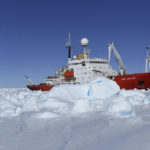Virtual Antarctica
Virtual Antarctica
- Start date
- 23 January, 2017
Virtual Antarctica uses the latest photographic image/scanning technology to produce immersive 360° virtual reality journeys through our research facilities. Whether you are a polar researcher planning your forthcoming Antarctic fieldwork, a teacher preparing lesson plans, or a friend of someone living and working in Antarctica, this innovative technology aims to give you an opportunity to discover this amazing world.
As well as exploring Antarctica on PCs, laptops or phones we will be taking VR headsets to events and exhibitions to give visitors a taste of what it’s really like to be in the frozen continent. We use a 3D camera to collect accurate visual and spatial data that enables us to map entire areas.
Phase one of the project
The first phase of this project (2017-18) involves BAS Creative Services Manager Pete Bucktrout capturing 3D images of our offices and laboratories in Cambridge, and at our Antarctic and sub-Antarctic research facilities. He’s been onboard the RRS James Clark Ross and will in future be creating a virtual tour for our new polar research ship RRS Sir David Attenborough.
Future phases
Augmented reality, where users can navigate through the 3D experience to discover more about our science, people, places or equipment are planned from 2018.
Coupled within these VR worlds will be embedded video, documents and sounds to help tell our engineering and science stories as well as allowing visitors to take journeys around our stations, ships and aircraft. We will also create access to a downloadable App giving full VR capabilities to your own mobile devices.
Test drive the demo VR 360°
- Explore Signy Research Station demo work in progress
- Explore Bird Island Research Station demo work in progress
- Explore RRS James Clark Ross demo work in progress
- Explore Aurora Cambridge demo work in progress
- Explore IceFloor an exhibition by RCA Artist Wayne Binitie
- Explore our Ice Core cold room and laboratiries
Virtual Antarctica has three distinct but related strands:
Science Communication
- enable scientific collaborators to view Antarctic research facilities
- utilise capability for augmented content about science on stations, ships and aircraft
Public engagement in research
- create an immersive virtual access to scientific and operational facilities using innovative technology
- provide deep insight into scientific research carried out in Antarctica
- create an exhibition asset for use in our partnerships with museums and science centres
Operational and engineering use
- provide an introduction to Antarctic research facilities for people preparing to work in Antarctica
- provide a virtual training environment for operational, engineering maintenance and technical teams preparing to work in Antarctica
- utilise capability to link to operational and building management software


